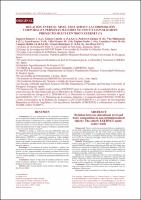Please use this identifier to cite or link to this item:
https://repositorio.usj.es/handle/123456789/362
| Title: | Relation between educational level and body composition in non-institutionalized elderly: The elderly EXERNET multi-center study |
| Authors: | Sagarra-Romero, Lucía


Gómez-Cabello, Alba 

Pedrero-Chamizo, R. 

Vila-Maldonado, S. 

Gusi-Fuertes, N. 

Villa-Vicente, J. G. 

Espino-Toron, L. 
Gonzalez-Gross, M. 
Casajus, José Antonio 


Vicente-Rodríguez, Germán 


Royo, Ignacio Ara 
|
| Keywords: | Aging; Educational Level; Obesity; Adiposity; Old People |
| Issue Date: | 30-Oct-2017 |
| Publisher: | MINISTERIO DE SANIDAD Y CONSUMO, PASEO DEL PRADO 18-20, MADRID, 28071, SPAIN |
| Citation: | Sagarra-Romero L, Gómez-Cabello A, Pedrero-Chamizo R, Vila-Maldonado S, Gusi-Fuertes N, Villa-Vicente JG, Espino-Torón L, González-Gross M, Casajús-Mallén JA, Vicente-Rodríguez G, Ara Royo I. Relación entre el nivel educativo y la composición corporal en personas mayores no institucionalizadas: Proyecto Multi-céntrico EXERNET. Rev Esp Salud Pública.2017;91:30 de octubre e201710041. |
| Abstract: | Background: There is an inverse association between educational level and body composition; however this association has strongly focused in young and adults population. The aim of this study was to analyze the educational levels attained in overweight and obesity Spanish elderly and to investigate if there was a correlation between having a low educational level and the risk of having overweight, central obesity or excess fat mass during the aging process. Methods: A representative sample of 2706 elderly (629 men and 2077 women; mean age of 72.1 +/- 5.3 years) from Spain were assessed in the elderly EXERNET multi-center study between 2008 and 2009. Body composition was assessed in all subjects by bioelectrical impedance. ANCOVA was used to compare the averages between the groups. Logistic regression was used to calculate the association between educational level and the risk of having overweight, central fat or obesity. Results: We observed significances between waist circumference and educational level in both sex (men 96.6 cm, women 86.3 cm); (p<0.05 and p<0.01, respective). There is an inverse association between the academic level, fat mass (29.5 kg) and percentage of body fat (40.8%) in women (p<0.05, p<0.01, respectively). No differences were observed in men. Conclusions: A low educational level increases the possibility of having overweight or obesity in women and to have an increased waist circumference in both sexes. |
| URI: | https://repositorio.usj.es/handle/123456789/362 |
| ISSN: | 1135-5727 |
| Appears in Collections: | Artículos de revistas |
Files in This Item:
| File | Description | Size | Format | |
|---|---|---|---|---|
| RS91C_201710041.pdf | 421 kB | Adobe PDF |  View/Open |
This item is licensed under a Creative Commons License

